HP Pavilion zt1100, Pavilion xz100, omnibook xt1000 Service Manual

HP Pavilion zt1100/xz100
Omnibook xt1000
Service Manual

Notice
In a continuing effort to improve the quality of our products, technical and environmental information in this document is subject to change without notice.
This manual and any examples contained herein are provided “as is” and are subject to change without notice. Hewlett-Packard Company makes no warranty of any kind with regard to this manual, including, but not limited to, the implied warranties of merchantability and fitness for a particular purpose. Hewlett-Packard Co. shall not be liable for any errors or for incidental or consequential damages in connection with the furnishing, performance, or use of this manual or the examples herein.
Consumer transactions in Australia and the United Kingdom: The above disclaimers and limitations shall not apply to Consumer transactions in Australia and the United Kingdom and shall not affect the statutory rights of Consumers.
© Copyright Hewlett-Packard Company 2000–2001. All rights reserved. Reproduction, adaptation, or translation of this manual is prohibited without prior written permission of Hewlett-Packard Company, except as allowed under the copyright laws.
The programs that control this product are copyrighted and all rights are reserved. Reproduction, adaptation, or translation of those programs without prior written permission of Hewlett-Packard Co. is also prohibited.
Portions of the programs that control this product may also be copyrighted by Microsoft Corporation, SystemSoft Corp., Insyde Software Corporation, S3 Graphics Incorporated, and Adobe Systems Incorporated. See the individual programs for additional copyright notices.
This product incorporates copyright protection technology that is protected by method claims of certain U.S. patents and other intellectual property rights owned by Macrovision Corporation and other rights owners. Use of this copyright protection technology must be authorized by Macrovision Corporation and is intended for home and other limited viewing uses only unless otherwise authorized by Macrovision Corporation. Reverse engineering or disassembly is prohibited.
Microsoft®, MS-DOS®, and Windows® are U.S. registered trademarks of Microsoft Corporation. Pentium® and the Intel Inside logo are U.S. registered trademarks and Celeron™ and SpeedStep™ are U.S. trademarks of Intel Corporation. Adobe® and Acrobat® are trademarks of Adobe Systems Incorporated.
All certifications may not be completed at product introduction. Check with your HP reseller for certification status.
This equipment is subject to FCC rules. It will comply with the appropriate FCC rules before final delivery to the buyer.
Hewlett-Packard Company
Mobile Computing Division
19310 Pruneridge Ave.
Cupertino, CA 95014, U.S.A.
Edition History
Edition 1......................... |
January 2002 |
ii |
HP Pavilion zt1100/xz100 Omnibook xt1000 |

Contents
Product Information ...................................................................................................... |
1-1 |
Technology Codes......................................................................................................................... |
1-2 |
Features ......................................................................................................................................... |
1-3 |
Operation....................................................................................................................................... |
1-6 |
Turning the Notebook On and Off ......................................................................................... |
1-6 |
Checking the Notebook’s Status ............................................................................................ |
1-7 |
Using Fn Hot Keys ................................................................................................................. |
1-8 |
Resetting the Notebook .......................................................................................................... |
1-9 |
Using the CD or DVD Player (selected models).................................................................. |
1-10 |
Specifications .............................................................................................................................. |
1-11 |
Hardware Specifications....................................................................................................... |
1-11 |
Internal Design ............................................................................................................................ |
1-14 |
Removal and Replacement ............................................................................................ |
2-1 |
Disassembly Flowchart.................................................................................................................. |
2-2 |
Removing the Battery (User-Replaceable).................................................................................... |
2-4 |
Removing a Plug-In Module (User-Replaceable) ......................................................................... |
2-5 |
Removing the Hard Disk Drive (User-Replaceable)..................................................................... |
2-6 |
Recovering and Reinstalling Software ................................................................................... |
2-8 |
Removing the Keyboard Cover (User-Replaceable) ..................................................................... |
2-9 |
Removing the Keyboard (User-Replaceable).............................................................................. |
2-11 |
Removing an SDRAM Module (User-Replaceable)................................................................... |
2-13 |
Removing an Expansion SDRAM Module .......................................................................... |
2-13 |
Removing the System SDRAM Module .............................................................................. |
2-14 |
Replacing Small Parts (User-Replaceable) ................................................................................. |
2-15 |
Removing the Mini-PCI Card (HP Authorized Service Providers Only).................................... |
2-16 |
Removing the Display Assembly (HP Authorized Service Providers Only) .............................. |
2-18 |
Removing Display Assembly Components (HP Authorized Service Providers Only) ............... |
2-20 |
Removing the Fan and Heatsink (HP Authorized Service Providers Only)................................ |
2-22 |
Removing the CPU Module (HP Authorized Service Providers Only) ...................................... |
2-25 |
Removing the Top Case (HP Authorized Service Providers Only) ............................................ |
2-27 |
Removing the Hinge Saddles (HP Authorized Service Providers Only) .................................... |
2-30 |
Removing the Motherboard or Bottom Case (HP Authorized Service Providers Only)............. |
2-32 |
Reinstalling the Motherboard ............................................................................................... |
2-34 |
Replacing the Bottom Case .................................................................................................. |
2-35 |
Removing Notebook Components (HP Authorized Service Providers Only) ............................ |
2-37 |
Troubleshooting and Diagnostics.................................................................................. |
3-1 |
Troubleshooting ............................................................................................................................ |
3-2 |
Checking for Customer Abuse ............................................................................................... |
3-3 |
Troubleshooting the Problem ................................................................................................. |
3-4 |
Verifying the Repair ............................................................................................................... |
3-4 |
Suggestions for Troubleshooting............................................................................................ |
3-5 |
Diagnostic Tools ......................................................................................................................... |
3-22 |
e-Diagtools Diagnostic Program .......................................................................................... |
3-22 |
Power-On Self-Test .............................................................................................................. |
3-25 |
Sycard PCCtest 450/460 CardBus Card (Optional) ............................................................. |
3-26 |
BIOS Configuration Utility .................................................................................................. |
3-27 |
HP Pavilion zt1100/xz100 Omnibook xt1000 |
iii |

Replaceable Parts ........................................................................................................... |
4-1 |
Reference Information ................................................................................................... |
5-1 |
Password Removal Policy............................................................................................................. |
5-1 |
Hewlett-Packard Display Quality Statement................................................................................. |
5-2 |
Figures
Figure 1-1. Front View......................................................................................................................... |
1-3 |
Figure 1-2. Back View......................................................................................................................... |
1-4 |
Figure 1-3. Bottom View ..................................................................................................................... |
1-5 |
Figure 1-4. Main Status Lights............................................................................................................. |
1-7 |
Figure 1-5. Keyboard Status Lights ..................................................................................................... |
1-8 |
Figure 1-6. Resetting the Notebook ..................................................................................................... |
1-9 |
Figure 1-7. Multimedia Buttons and Status Panel.............................................................................. |
1-10 |
Figure 1-8. Replaceable Module Diagram......................................................................................... |
1-14 |
Figure 2-1. Disassembly Flow.............................................................................................................. |
2-2 |
Figure 2-2. Removing the Battery........................................................................................................ |
2-4 |
Figure 2-3. Releasing the Plug-in Module ........................................................................................... |
2-5 |
Figure 2-4. Removing the Hard Disk Drive......................................................................................... |
2-6 |
Figure 2-5. Removing the Hard Disk Tray .......................................................................................... |
2-7 |
Figure 2-6. Removing the Keyboard Cover Retaining Screws ............................................................ |
2-9 |
Figure 2-7. Removing the Keyboard Cover ....................................................................................... |
2-10 |
Figure 2-8. Loosening the Keyboard Retaining Screws..................................................................... |
2-11 |
Figure 2-9. Disconnecting the Keyboard ........................................................................................... |
2-12 |
Figure 2-10. Removing an Expansion SDRAM Module................................................................... |
2-13 |
Figure 2-11. Installing an Expansion SDRAM Module..................................................................... |
2-14 |
Figure 2-12. Removing the System SDRAM Module ....................................................................... |
2-14 |
Figure 2-13. Removing the Mini-PCI Card ....................................................................................... |
2-17 |
Figure 2-14. Removing the Display (1) ............................................................................................. |
2-18 |
Figure 2-15. Removing the Display (2) ............................................................................................. |
2-19 |
Figure 2-16. Removing Display Assembly Components ................................................................... |
2-21 |
Figure 2-17. Removing the Fan and Heatsink.................................................................................... |
2-23 |
Figure 2-18. Installing a New Thermal Pad ....................................................................................... |
2-24 |
Figure 2-19. Removing the CPU Module .......................................................................................... |
2-26 |
Figure 2-20. Removing the Top Case Retaining Screws ................................................................... |
2-28 |
Figure 2-21. Removing the Top Case ................................................................................................ |
2-29 |
Figure 2-22. Removing the Hinge Saddles ........................................................................................ |
2-31 |
Figure 2-23. Removing the Motherboard........................................................................................... |
2-33 |
Figure 2-24. Installing the Docking Doors ........................................................................................ |
2-35 |
Figure 2-25. Installing the PCMCIA Doors....................................................................................... |
2-35 |
Figure 2-26. Example of Serial Number Label .................................................................................. |
2-36 |
Figure 3-1. Basic Troubleshooting Steps............................................................................................. |
3-2 |
Figure 3-2. e-Diagtools Screens — Basic and Advanced .................................................................. |
3-22 |
Figure 3-3. Parallel Loopback Connector .......................................................................................... |
3-24 |
Figure 4-1. Exploded View.................................................................................................................. |
4-2 |
iv |
HP Pavilion zt1100/xz100 Omnibook xt1000 |

Tables
Table 1-1. Pavilion zt1100/xz100 and Omnibook xt1000 Series Models............................................ |
1-1 |
|
Table 1-2. Activating Power Modes .................................................................................................... |
1-6 |
|
Table 1-3. Fn Hot Keys ........................................................................................................................ |
1-8 |
|
Table 1-4. Pavilion zt1100/xz100 and Omnibook xt1000 Series Hardware Specifications .............. |
1-11 |
|
Table 1-5. Pavilion zt1100/xz100 and Omnibook xt1000 Series Accessories................................... |
1-13 |
|
Table 1-6. Functional Structure.......................................................................................................... |
1-15 |
|
Table 2-1. Removal Cross-Reference .................................................................................................. |
2-1 |
|
Table 2-2. Required Equipment ........................................................................................................... |
2-3 |
|
Table 2-3. Recommended Screw Torques ........................................................................................... |
2-3 |
|
Table 2-4. Replacing Small Parts (User-Replaceable)....................................................................... |
2-15 |
|
Table 2-5. Removing Notebook Components.................................................................................... |
2-37 |
|
Table 3-1. Scope of Diagnostic Tools.................................................................................................. |
3-5 |
|
Table 3-2. Troubleshooting Suggestions.............................................................................................. |
3-5 |
|
Table 3-3. Insyde MobilePRO BIOS POST Beep Codes and Messages........................................... |
3-25 |
|
Table 3-4. Sycard PCCtest Commands .............................................................................................. |
3-26 |
|
Table 3-5. |
BIOS Configuration Menus and Parameters .................................................................... |
3-27 |
Table 4-1. |
Replaceable Parts for the Pavilion zt1100/xz100 Series..................................................... |
4-3 |
Table 4-2. |
Replaceable Parts for the Omnibook xt1000 Series ........................................................... |
4-5 |
Table 5-1. |
TFT LCD Guidelines (14.1/15.0-in XGA) ......................................................................... |
5-3 |
HP Pavilion zt1100/xz100 Omnibook xt1000 |
v |

Introduction
This manual provides reference information for servicing HP Pavilion zt1100/xz100 and Omnibook xt1000 notebook PCs. It is for use by HP-authorized service personnel while installing, servicing, and repairing these products.
The manual is designed as a self-paced guide that will train you to install, configure, and repair these notebooks. The manual is self-contained, so you can follow it without having equipment available.
The following table lists other sources of information about the notebook and related products.
Source |
Address or Number |
Comments |
HP Notebook web site
HP Business Support web Site
http://www.hp.com/notebooks
(European mirror: http://www.europe.hp.com/notebooks)
www.hp.com/go/bizsupport
HP Partnership web site |
http://partner.americas.hp.com |
Restricted to Authorized Resellers |
|
|
only. |
HP Asia Pacific Channel |
http://www.hp.com.au |
Restricted to DPSP Partners only. |
Support Centre for DPSP |
|
|
Partners |
|
|
HP/MCD web site |
http://www.mcd.hp.com |
HP’s internal web site for division |
|
|
information. |
America Online |
Keyword: HP |
Call (800) 827-6364 for membership |
|
|
within the US. |
CompuServe |
GO HP |
Call (800) 524-3388 for membership |
|
|
within the US. |
HP Support Assist CD |
(800) 457-1762 |
US and Canada. |
|
(801) 431-1587 |
Outside US and Canada. |
Microsoft Windows manual |
|
Information about Windows operating |
|
|
system. |
Microsoft web site |
http://www.microsoft.com |
Information and updates for Windows |
|
|
operating systems. |
vi |
HP Pavilion zt1100/xz100 Omnibook xt1000 |
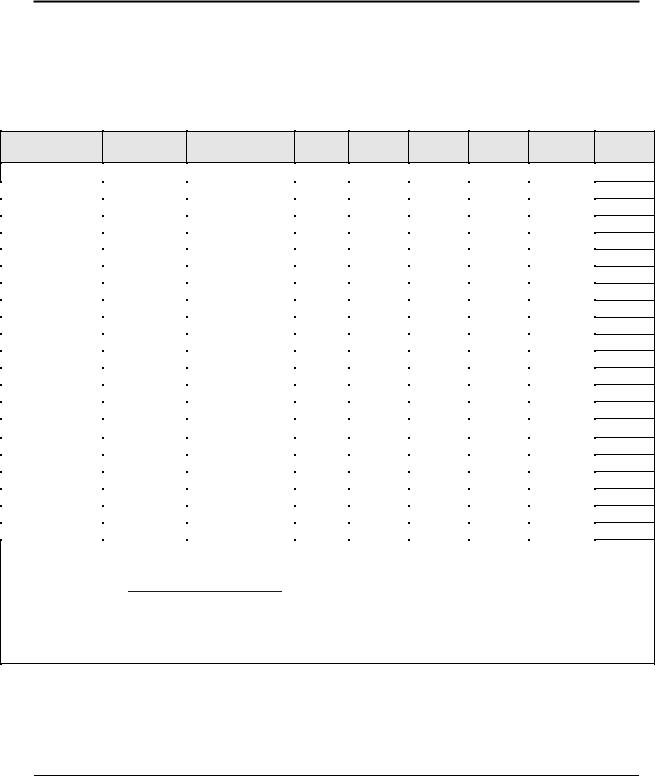
1
Product Information
The HP Pavilion zt1100/xz100 and Omnibook xt1000 series are reliable notebook computers for the budget-minded user—whether at school, at home, or as part of a growing business—who wants a thin, light notebook that will meet basic mobile computing needs.
Table 1-1. Pavilion zt1100/xz100 and Omnibook xt1000 Series Models
Product |
CPU 1 |
Display |
Hard |
Standard |
CD/DVD |
|
|
|
Drive |
SDRAM |
drive 2 |
Pavilion zt1100/xz100 |
|
|
|
|
|
F3377H / zt1120 |
Cel 1.06 GHz |
14.1-in TFT XGA |
20 GB |
256 MB |
DVD |
F3378H / zt1130 |
Cel 1.13 GHz |
14.1-in TFT XGA |
20 GB |
256 MB |
Combo |
F3379H / zt1150 |
Cel 1.2 GHz |
15.0-in TFT XGA |
20 GB |
256 MB |
Combo |
F3380H / zt1170 |
PIII 1.13 GHz |
15.0-in TFT XGA |
30 GB |
512 MB |
Combo |
F3387H / zt1180 |
PIII 1.2 GHz |
15.0-in TFT SXGA+ |
40 GB |
512 MB |
Combo |
F3381H / zt1190 |
PIII 1.2 GHz |
15.0-in TFT SXGA+ |
40 GB |
512 MB |
Combo |
F3386H / xz185 |
PIII 1.13 GHz |
15.0-in TFT XGA |
40 GB |
512 MB |
Combo |
F3382H / zt1121s |
Cel 1.06 GHz |
14.1-in TFT XGA |
20 GB |
128 MB |
DVD |
F3388H / zt1131s |
Cel 1.06 GHz |
14.1-in TFT XGA |
20 GB |
256 MB |
DVD |
F3390H / zt1141s |
Cel 1.2 GHz |
14.1-in TFT XGA |
20 GB |
256 MB |
Combo |
F3383H / zt1141 |
Cel 1.06 GHz |
14.1-in TFT XGA |
20 GB |
256 MB |
Combo |
F3389H / zt1151 |
Cel 1.06 GHz |
15.0-in TFT XGA |
20 GB |
256 MB |
Combo |
F3391H / zt1161 |
Cel 1.2 GHz |
15.0-in TFT XGA |
20 GB |
512 MB |
Combo |
F3384H / zt1171 |
PIII 1.06 GHz |
15.0-in TFT XGA |
20 GB |
256 MB |
Combo |
Omnibook xt1000 |
|
|
|
|
|
F3428H / xt1000s |
Cel 1.13 GHz |
14.1-in TFT XGA |
20 GB |
256 MB |
DVD |
F3429H / xt1000 |
PIII 1.13 GHz |
14.1-in TFT XGA |
20 GB |
256 MB |
DVD |
F3430H / xt1000 |
PIII 1.13 GHz |
14.1-in TFT XGA |
20 GB |
256 MB |
Combo |
F3431H / xt1000 |
PIII 1.13 GHz |
15.0-in TFT XGA |
30 GB |
256 MB |
Combo |
F3432H / xt1000 |
PIII 1.20 GHz |
15.0-in TFT XGA |
30 GB |
256 MB |
Combo |
F3433H / xt1000 |
PIII 1.20 GHz |
15.0-in TFT SXGA+ |
30 GB |
512 MB |
Combo |
FullModem/ featured 3 LAN
No |
56K/LAN |
No |
56K/LAN |
Yes |
56K/LAN |
Yes |
56K/LAN |
Yes |
56K/LAN |
Yes |
56K/LAN |
Yes |
56K/LAN |
No |
56K/LAN |
No |
56K/LAN |
No |
56K/LAN |
Yes |
56K/LAN |
Yes |
56K/LAN |
Yes |
56K/LAN |
Yes |
56K/LAN |
|
|
No |
56K/LAN |
Yes |
56K/LAN |
Yes |
56K/LAN |
Yes |
56K/LAN |
Yes |
56K/LAN |
Yes |
56K/LAN |
Wireless |
802.11b
This table lists only base product configurations—custom configurations are not included.
7KH H[DFW FRQILJXUDWLRQ RI D XQLW LV FDSWXUHG LQ D 7UDFHDELOLW\ GDWDEDVH 6XSSRUW DJHQWV FDQ DFFHVV WKLV GDWDEDVH WR YHULI\ D SURGXFW¶V FRQILJXUDWLRQ DW WKLV 85/ KWWS ZZZ SF WUDFNLQJ KS FRP
1
2
3
Intel Mobile Pentium III (PIII-M) or Celeron-T (Cel) processor. Combo optical drive = DVD + CD-RW.
Full-featured SKUs include multimedia buttons, LCD status display, and IEEE1394.
HP Pavilion zt1100/xz100 Omnibook xt1000 |
Product Information |
1-1 |

Technology Codes
HP does not change the name of a product every time the product’s technology changes. While this helps ensure continuing market momentum for HP products, it complicates technology deployment and support processes.
To help solve this problem, HP has added a technology code to the serial number of each of its products. Since the BIOS must be matched to the notebook’s hardware, the same code is used for the BIOS and the hardware. This manual refers to technology code deferences where applicable.
The table below shows the technology codes and the changes they signify for the products. Before downloading software or drivers or performing repairs, note the technology code for the HP notebook model.
Note that the first two characters of the BIOS ID (for example, IB.M1.02) indicate the hardware technology. You can also determine the BIOS ID using the BIOS configuration utility, or by pressing Esc during the boot process when the HP logo appears.
This manual contains service information for products with the following technology code.
Technology code
IB
Product name
Pavilion zt1100/xz100 series Omnibook xt1000 series
Details
Intel Pentium III-M and Celeron-T based platform supported with Via chipset and S3 integrated graphics.
1-2 |
Product Information |
HP Pavilion zt1100/xz100 Omnibook xt1000 |
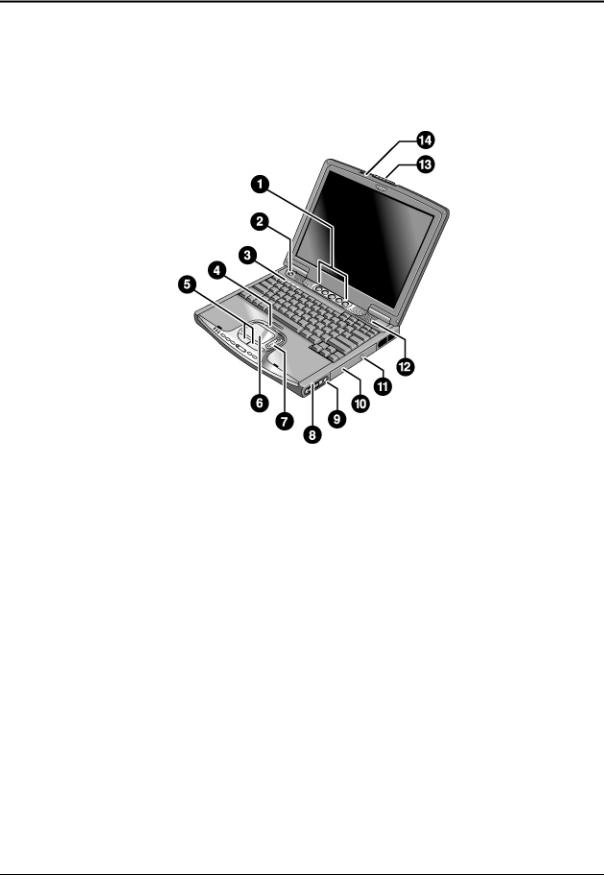
Features
The following illustrations show the notebook’s main external features. For an exploded view of the notebook, see page 4-2.
Figure 1-1. Front View
1.One-Touch buttons.
2.Power button.
3.Keyboard status lights: Caps Lock, Num Lock, CD drive activity.
4.Touch pad/scroll pad on-off button (with on-off indicators on either side).
5.Left and right click buttons.
6.Touch pad.
7.Scroll pad
8.Volume controls (selected models).
9.Mute button and indicator light (selected models).
10.Removable CD, DVD, CD-RW, or DVD/CD-RW drive.
11.CD/DVD eject button.
12.Speaker (one on each side).
13.Latch.
14.Built-in microphone.
HP Pavilion zt1100/xz100 Omnibook xt1000 |
Product Information |
1-3 |
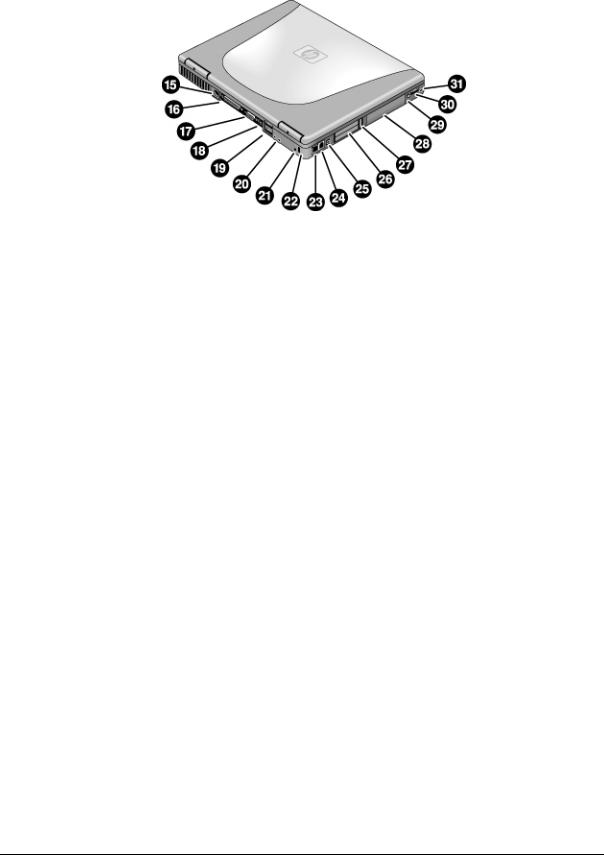
Figure 1-2. Back View
15.AC adapter jack.
16.Parallel port (LPT1) (colored burgundy).
17.External monitor (VGA) port (colored blue).
18.S-video (TV out) port (colored yellow) (selected models).
19.Universal serial bus (USB) ports (2).
20.Audio line-out jack (colored lime green) and external microphone jack (colored pink).
21.Reset switch.
22.Kensington lock slot (security connector).
23.LAN port and indicators.
24.Modem port (selected models).
25.IEEE 1394 connector (selected models).
26.PC Card slot (Type II or Type III, lower slot only).
27.PC Card eject button.
28.Hard disk drive.
29.Wireless on-off button and indicator light (selected models).
30.Universal serial bus (USB) port.
31.Headphone jack (colored lime green).
1-4 |
Product Information |
HP Pavilion zt1100/xz100 Omnibook xt1000 |
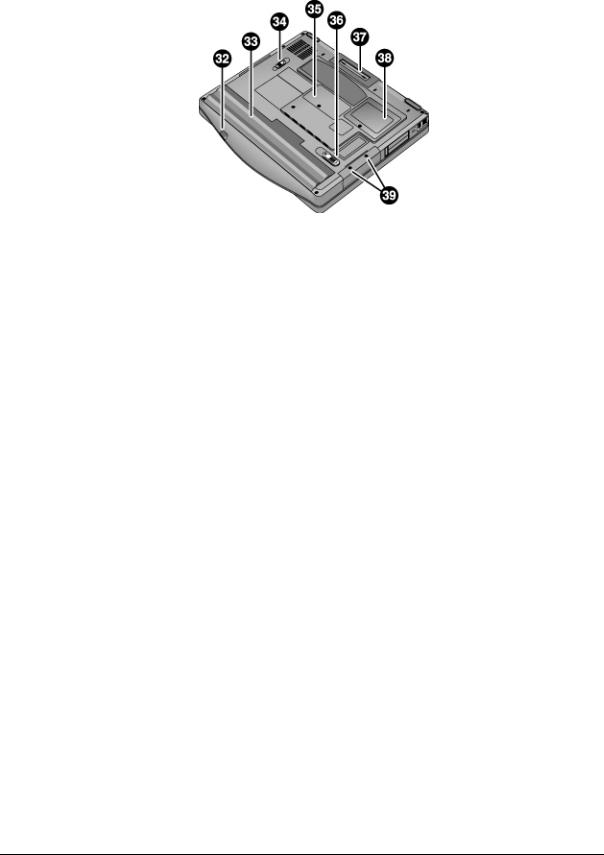
Figure 1-3. Bottom View
32.Infrared port (selected models).
33.Battery.
34.CD/DVD drive latch.
35.Expansion SDRAM cover.
36.Battery latch.
37.Docking port.
38.Mini-PCI cover.
39.Hard disk drive retaining screws.
HP Pavilion zt1100/xz100 Omnibook xt1000 |
Product Information |
1-5 |

Operation
This section gives an overview of the notebook’s operation.
Turning the Notebook On and Off
You can start and stop the notebook using its power button. However, at times you may want to use other methods to start or stop the notebook—depending on power considerations, types of active connections, and start-up time.
Note
This manual describes the notebook in its original factory configuration, with all settings at their default values.
Table 1-2. Activating Power Modes
Power mode
On
Power mode status light is green.
Standby
Maintains current session in RAM.
Turns off the display and other components. Saves significant power.
Restarts quickly.
Restores network connections. Power mode status light is amber.
To enter this mode
Press the power button.
Click Start, Turn Off Computer, Stand By
–or–
press the power button
–or–
allow timeout.
To turn on again
Press the power button to quickly resume your session.
Hibernation
Saves current session to disk, then turns off. Saves maximum power.
Restores network connections. Power mode status light is off.
Turn off
Turns off without saving current session. Saves maximum power.
At startup, resets everything, and starts a new session.
Power mode status light is off.
Click Start, Turn Off Computer, then press and hold Shift and click Hibernate
–or–
allow timeout.
Click Start, Turn Off Computer, Turn Off
–or–
press and hold the power button for four seconds (only if the Start menu procedure doesn’t work).
Press the power button to resume your session.
Press the power button to start with a new session.
1-6 |
Product Information |
HP Pavilion zt1100/xz100 Omnibook xt1000 |
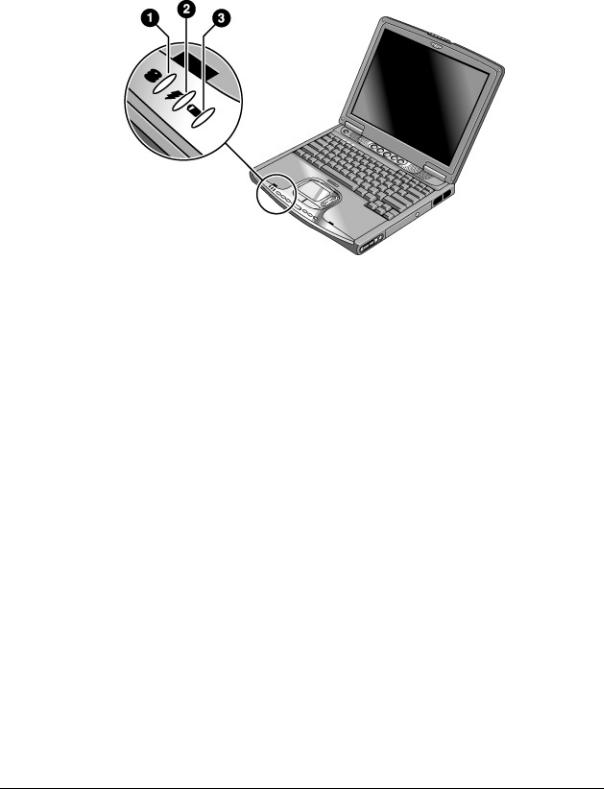
Checking the Notebook’s Status
The notebook’s status lights report power and battery status, keyboard status, and drive activity.
Figure 1-4. Main Status Lights
1.Hard disk drive activity.
•On: the notebook is accessing the hard disk drive.
2.Power mode.
•Green: the notebook is on (even if the display is off).
•Amber: the notebook is on standby.
•Off: the notebook is off or in hibernation.
3.Battery charge status.
•Green: the AC adapter is connected and the battery is fully charged.
•Amber: the AC adapter is connected and the battery is charging.
•Red: the AC adapter is connected and the battery has a fault.
•Off: the AC adapter is not connected or the battery is missing.
HP Pavilion zt1100/xz100 Omnibook xt1000 |
Product Information |
1-7 |
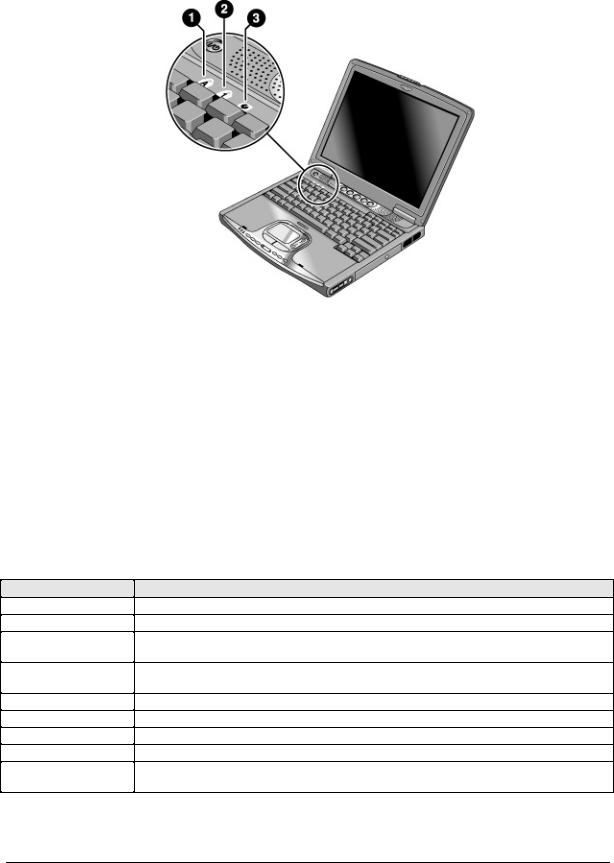
Figure 1-5. Keyboard Status Lights
1.Caps Lock. Caps Lock is active.
2.Num Lock. Num Lock is active. (The Keypad Lock must also be on to use the embedded keypad.)
3.CD drive activity. The CD drive is active.
Using Fn Hot Keys
The combination of the Fn key plus another key creates a hot key—a shortcut key sequence—for various system controls. To use a hot key, press and hold Fn, press the appropriate second key, then release both keys.
Hot Key
Fn+F1
Fn+F2
Fn+F5
Fn+F8
Fn+Num Lock
Fn+Page Up
Fn+Page Down
Fn+Backspace
Fn+any One-Touch button
Table 1-3. Fn Hot Keys
Effect
Decreases the display brightness.
Increases the display brightness.
Toggles among the built-in display, an external display, and simultaneous display on both.
Toggles the built-in numeric keypad on and off. Does not affect an external keyboard. If Num Lock is on, the numeric functions are active; otherwise, cursor control is active.
Toggles Scroll Lock on and off.
Increases the volume (and turns audio on if muted).
Decreases the volume.
Toggles the mute function on and off.
Toggles the One-Touch button LEDs on and off (selected models).
1-8 |
Product Information |
HP Pavilion zt1100/xz100 Omnibook xt1000 |
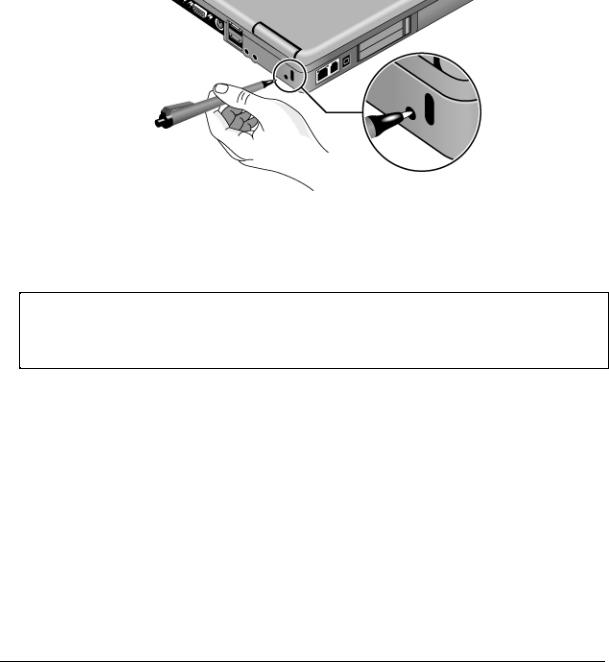
Resetting the Notebook
Occasionally, Windows or the notebook may stop responding, so that you cannot turn the notebook off. If this happens, try the following in the order listed:
•If possible, shut down Windows: click Start, Turn Off Computer, Turn Off.
•Press Ctrl+Alt+Del, then click Shut Down.
•Press and hold the power button for about four seconds, until the display turns off.
•Use a pen or straightened paper clip to press the reset switch on the back of the notebook.
Figure 1-6. Resetting the Notebook
Press the power button to turn the notebook on again.
Note
To boot from a CD or DVD, insert a bootable CD (such as the Recovery CDs) into the drive, then restart. Press Esc when the HP logo appears, then select the CD-ROM/DVD drive as the temporary boot device.
HP Pavilion zt1100/xz100 Omnibook xt1000 |
Product Information |
1-9 |
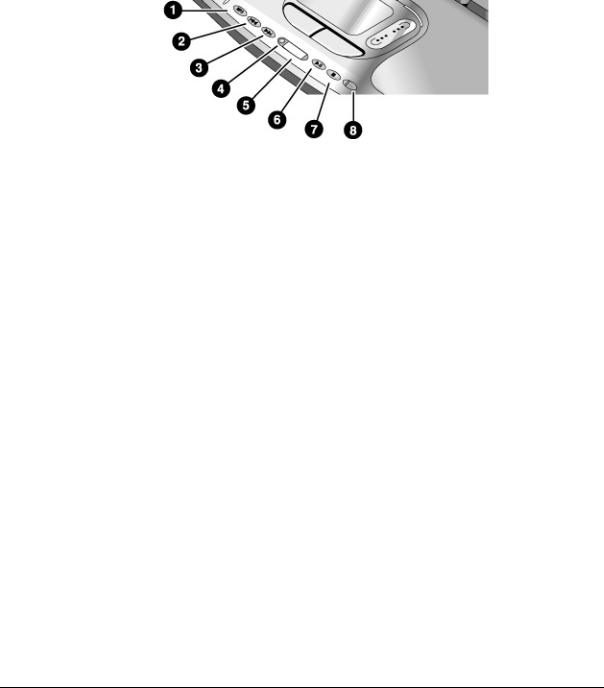
Using the CD or DVD Player (selected models)
The multimedia buttons on the front of the notebook control the CD/DVD player, and work in much the same way as do the controls of a standalone CD or DVD player. The player operates whether the notebook is on, off, on standby, or in hibernation. (When the notebook is on, the volume control buttons also govern the volume for most audio applications.)
If the notebook is off, on standby, or in hibernation, slide the multimedia power switch to the left to activate the player. For details about using the CD/DVD player, see the notebook’s Reference Guide.
Figure 1-7. Multimedia Buttons and Status Panel
1. |
MP3 player launch button. |
5. |
Status panel. |
2. |
Previous track button. |
6. |
Play/Pause button. |
3. |
Next track button. |
7. |
Stop button. |
4. |
Status panel button. |
8. |
Multimedia power switch and indicator light. |
1-10 Product Information |
HP Pavilion zt1100/xz100 Omnibook xt1000 |

Specifications
The following tables list the specifications for the notebook and its accessories. These are subject to change: for the latest versions, see the HP Notebook web site, www.hp.com/notebooks (in Europe: www.europe.hp.com/notebooks).
Hardware Specifications
Table 1-4. Pavilion zt1100/xz100 and Omnibook xt1000 Series Hardware Specifications
Physical Attributes
Processor and
Bus Architecture
Graphics
Power
Mass Storage
CD/DVD drive
SDRAM
Audio System
Dimensions:
13.3/14.1-in models: 318 × 273 × 35.8 mm (12.5 × 10.75 × 1.4 in). 15-in models: 330 × 278 × 37.5 mm (12.99 × 10.94 × 1.47 in). Thickness varies across unit.
Weight: 2.3 kg (5.0 lbs) minimum, depending on model.
Intel Mobile Pentium III-M processor (starting at 933 MHz) with SpeedStep technology.
–or–
Intel Celeron processor (starting at 866 MHz). 1.6-V core, 2.5-V external, low-power processor. 32-bit PCI bus.
13.3/14.1/15-in XGA (1024x768) or 15-in SXGA+ (1400x1050) TFT LCD display. Supports 16 million colors, 3D and OpenGL graphics.
Supports hardware acceleration for MPEG. Display driver supports MPEG2 overlay. Supports simultaneous LCD+CRT operation (same image on both displays). Integrated VGA.
Up to 32-MB video memory (shared with system memory). Supports NTSC and PAL TV.
Dual display for LCD and external monitor or TV.
Rechargeable lithium-ion or NiMH battery.
Battery life depends on notebook type and usage, and battery type and calibration. Low-battery warning.
Standby/hibernate and resume capability.
Universal AC adapter: 100–240 Vac (50/60 Hz) input, 19 Vdc output, 60 W.
10to 40-GB removable IDE hard disk drive. Supports optional 1.44-MB floppy disk drive module.
24X CD-ROM, 8X DVD, 8X8X24 CD-RW, or 8X8X24X8 DVD/CD-RW (or higher) removable drive.
Two slots for SDRAM expansion (SODIMM, PC133) up to 1024 MB (2x512MB). 133-MHz RAM bus.
Built-in microphone.
Stereo sound through two built-in speakers. 1.5 W per channel. Polk Audio certified on 15-in models.
Dedicated mute and volume controls (selected models).
CD player (can play while notebook is on standby, in hibernation, or off). 3D-enhanced PCI bus audio.
HP Pavilion zt1100/xz100 Omnibook xt1000 |
Product Information 1-11 |

Keyboard and
Pointing Devices
Input/Output
Expandability
Security Features
Environmental Limits
Major ICs
87/88/91-key touch-type QWERTY keyboard with 101/102 key emulation. Embedded numeric keypad.
12 function (Fn) keys.
5 user-programmable One-Touch buttons. Touch pad with lock button and on-off indicator. Left and right click buttons, vertical scroll pad.
3 universal serial bus (USB) ports.
15-pin VGA video-out (blue) with DDC support. (Resolution up to 1600×1200×64K or 16M colors. Refresh rate of 60 to 100 Hz, depending on resolution and color depth.) RJ-45 LAN jack.
25-pin bi-directional high-speed ECP/EPP parallel (burgundy). S-video TV out (yellow) (selected models).
4-Mbps IrDA-compliant infrared port (selected models). IEEE 1394 port (selected models).
Docking port: supports optional simple port replicator.
One Type II or Type III 16/32-bit PC Card slot (3.3- and 5-V support). CardBus enabled.
Optional simple port replicator (selected models).
User and administrator passwords.
DMI-accessible electronic serial number.
Kensington MicroSaver lock slot.
Operating temperature: 0 to 40 °C (32 to 104 °F). Operating humidity: 10 to 90 percent RH (0 to 45 °C). Operating altitude: up to 10,000 ft (3000 m) at 25 °C (77 °F).
Storage (non-operating) temperature: –20 to 65 °C (–4 to 149 °F).
CPU: Intel Mobile Pentium III or Celeron processor.
North Bridge: VIA Pro Savage Pn 133T.
South Bridge: VIA VT8231.
Display controller: S3 Savage 4 in North Bridge.
Audio controller: VIA/Realtek ALC201 AC97 Codec.
CD player controller: O2 OZ-163.
LAN: Realtek RTL8100L.
CardBus controller: ENE 1410.
Keyboard/embedded controller: National NS87591.
Super I/O: in South Bridge.
1-12 Product Information |
HP Pavilion zt1100/xz100 Omnibook xt1000 |

Table 1-5. Pavilion zt1100/xz100 and Omnibook xt1000 Series Accessories
Accessory |
Description |
New Accessories |
|
F3172A |
Standard LiIon Battery |
F3491A |
CD-RW Upgrade Module |
F3492A |
DVD Upgrade Module |
F3493A |
CD-RW/DVD Combo Drive |
F3494A |
Simple Port Replicator |
Tested Cross-Platform Accessories |
|
D9510B |
USB Floppy Disk Drive Module |
F1455A |
Auto Air Adapter (75 W) |
F1606A |
Omnibook Ballistic Nylon Case |
F1607A |
Omnibook Leather Case |
F1608A |
Omnibook Executive Case |
F1626B |
3COM 10/100 Enet PC Card |
F1645A |
Kensington Lock |
F1747A |
Defcon Alarm |
F1771A |
Universal Carrying Case |
F1778A |
Promotional Carrying Case (NAM & AP) |
F1778B |
Standard Carrying Case (Europe Only) |
F1781A |
Ultra Slim Line Adapter (60 W) |
F1782A |
3COM Type II Combo Card |
F2020A |
Executive Leather Case (Europe only) |
F2135B |
Wireless Comm Access Point |
F2135C |
Wireless Comm Access Point |
F2136B |
Wireless PC Card (128 bits) |
F2196A |
3Com Bluetooth PC Card |
F2297A |
Car Adapter, 24 V (EU only) |
F2298A |
512 MB PC133 SDRAM |
F3495A |
128 MB PC133 SDRAM |
F3496A |
256 MB PC133 SDRAM |
P1980A |
USB Wireless LAN 802.11b |
P1981A |
USB Wireless LAN Access Point |
HP Pavilion zt1100/xz100 Omnibook xt1000 |
Product Information 1-13 |
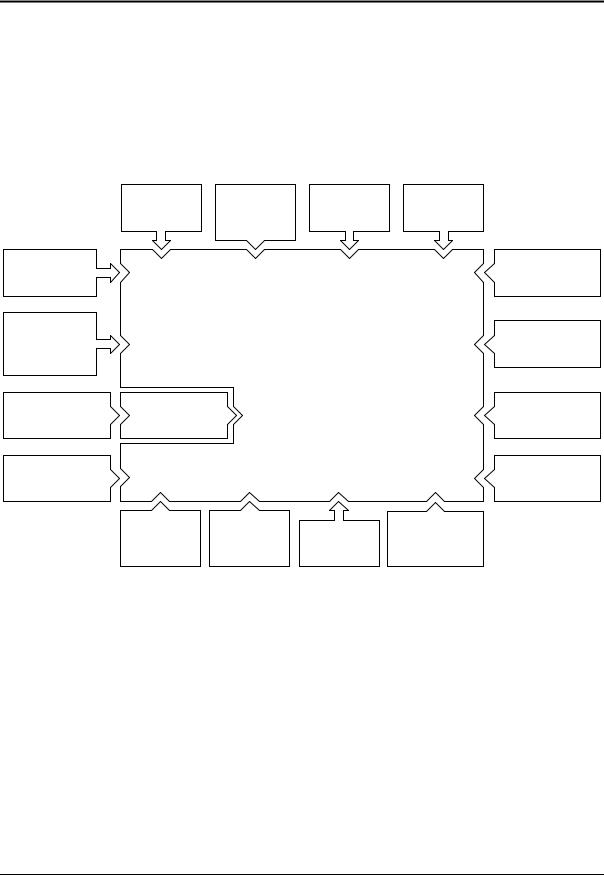
Internal Design
The motherboard PCA is the central component of the notebook’s design, and plays a role in virtually all system functions. The CPU module and most other subsystems connect to the motherboard.
The following figure shows the electrical connections among the notebook’s replaceable electronic modules. In addition, the table on page 1-15 lists the roles that the replaceable modules play in each of the notebook’s functional subsystems.
Speakers |
CPU module |
Display |
Keyboard |
|
cover switch |
||||
assembly |
||||
|
|
PCA |
||
|
|
|
||
Fan |
|
|
Mini-PCI card |
Top case |
|
|
Motherboard PCA |
|
touch/scroll pads, |
|
|
|
CD/DVD drive |
click buttons, CD |
|
|
|
|
|
|
|
|
|
player, IR (optional) |
|
|
|
|
PCMCIA card |
PCMCIA |
|
|
SDRAM modules |
socket |
|
|
||
|
|
|
|
|
Hard disk drive |
|
|
|
Volume control |
|
|
|
PCA |
|
|
|
|
|
|
|
Bluetooth |
USB PCA |
Keyboard |
Battery |
|
PCA |
|||
|
|
|
||
|
|
|
|
Figure 1-8. Replaceable Module Diagram
1-14 Product Information |
HP Pavilion zt1100/xz100 Omnibook xt1000 |

Function
Bootup
Processor
Memory
Power
Display
Hard disk
Keyboard
Touch pad
Audio
Status
Parallel
USB
PCMCIA
Infrared
Wireless
Docking
PC card
Table 1-6. Functional Structure
Components Used
CPU module Motherboard Hard disk drive
CD/DVD drive module
CPU module
Motherboard
SDRAM module
Component Roles
Main processor.
Primary system circuitry.
First source of disk-based startup code.
Second source of disk-based startup code.
Main processor, numeric data processor, L1 and L2 cache. Primary system circuitry.
Video RAM (shared).
Changeable RAM (2 slots).
Battery
Motherboard
Keyboard cover switch PCA AC adapter
Motherboard
Display assembly
Motherboard
Hard disk drive
Motherboard Keyboard Keyboard cover CD player PCA
Motherboard
Top case
Motherboard
Display assembly USB PCA
Volume control PCA Speakers
Motherboard Top case Keyboard cover switch PCA CD player PCA
Motherboard
Motherboard
USB PCA
Motherboard PCMCIA sockets
Motherboard
CD player PCA
Display assembly Motherboard Mini-PCI PCA Bluetooth PCA USB PCA
Motherboard
Motherboard
Power storage.
Power control circuitry, AC adapter socket, lid switch, reset switch, power supply.
Power button.
AC-to-DC converter.
Video controller, display drivers, LVDS processing, display/graphics controller.
Display output, backlight, power converter for backlight.
Hard disk controller.
Hard disk mechanism.
Keyboard controller, keyboard BIOS.
Key switches.
One-Touch buttons.
CD player buttons.
Keyboard BIOS.
Touch/scroll pad sensors, click buttons.
Audio controller, audio decoder, speaker amplifier, external microphone jack.
Microphone. Headphone jack. Volume control. Sound output.
LED circuitry, keyboard controller.
Status LEDs.
Status LEDs.
CD/DVD status display.
I/O controller, parallel connector.
Bus controller, USB connectors.
USB connectors.
PCMCIA controller.
PCMCIA connectors.
I/O controller.
Infrared transmitter/receiver.
Antennas, on-off button, indicator light.
I/O controller.
Radio PCA circuitry.
Radio PCA circuitry.
On-off button, indicator light.
Docking logic, docking connector.
PC card controller, PC card connector.
HP Pavilion zt1100/xz100 Omnibook xt1000 |
Product Information 1-15 |
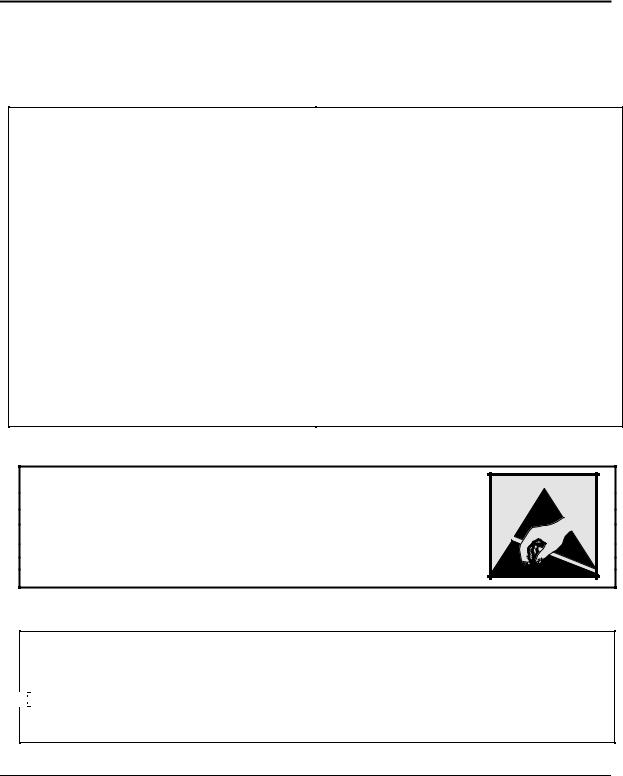
2
Removal and Replacement
This chapter shows how to remove and replace the notebook’s components, listed in the following table. The items marked by • are user-replaceable.
Table 2-1. Removal Cross-Reference
Antenna, Bluetooth (page 2-20).
Antenna, wireless (page 2-20).
•Battery (page 2-4).
Bezel, display (page 2-20). Card, mini-PCI (page 2-16). Case, bottom (page 2-32).
Case, top (page 2-27).
•Cover, expansion SDRAM (page 2-15).
•Cover, keyboard (page 2-9).
•Cover, mini-PCI (page 2-15).
•Covers, screw (page 2-15). Display assembly (page 2-18). Doors, docking (page 2-35). Doors, PCMCIA (page 2-35).
•Drive, hard disk (page 2-6). Fan (page 2-22).
•Feet, rubber (page 2-15).
Guide, hard disk drive (page 2-38). Heatsink (page 2-22).
•Keyboard (page 2-11). Module, CPU (page 2-25).
•Module, plug-in (page 2-5).
•Module, expansion SDRAM (page 2-13).
•Module, system SDRAM (page 2-14). PCA, CD player (page 2-38).
PCA, inverter (page 2-20) PCA, motherboard (page 2-32). PCA, USB (page 2-38).
PCA, volume control (page 2-39). Saddles, hinge (page 2-30). Socket, PCMCIA (page 2-39). Speaker, left (page 2-39). Speaker, right (page 2-39).
•Tray, hard disk drive (page 2-7).
Caution
Always provide proper grounding when performing repairs. Without proper grounding, an electrostatic discharge can damage the notebook and its components.
Notes
To reassemble a component, perform the removal procedure in reverse order. Any special notes required for reassembly are included at the end of each section.

 Symbols like this are used throughout this chapter to show approximate full-size screw outlines. Use these to verify the sizes of screws before you install them. Installing a wrong-size screw can damage the notebook. (The symbol shown represents an M2.5×5mm T-head screw.)
Symbols like this are used throughout this chapter to show approximate full-size screw outlines. Use these to verify the sizes of screws before you install them. Installing a wrong-size screw can damage the notebook. (The symbol shown represents an M2.5×5mm T-head screw.)
HP Pavilion zt1100/xz100 Omnibook xt1000 |
Removal and Replacement |
2-1 |
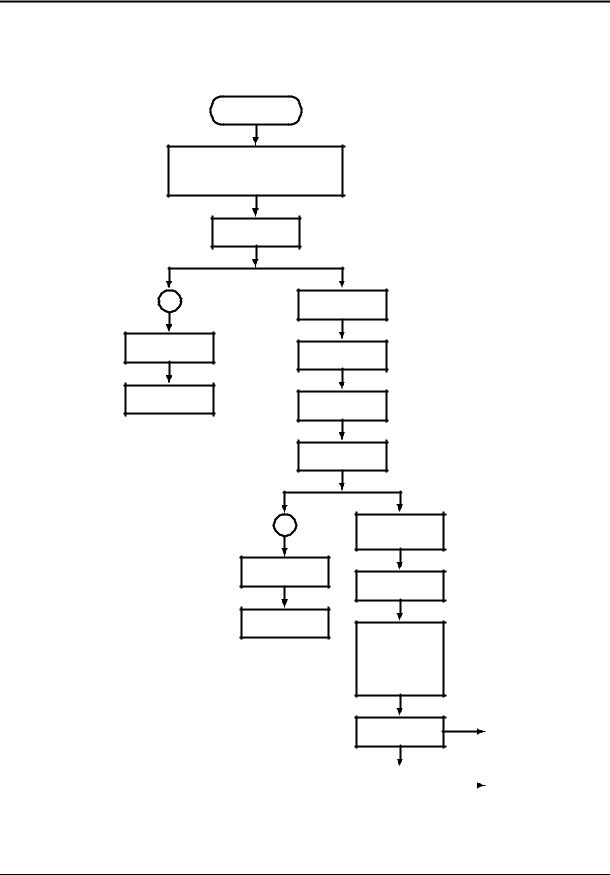
Disassembly Flowchart
The following diagram shows the general “paths” you will use in disassembling the notebook to access any particular component.
Start
Battery, AC adapter, secondary SDRAM module, mini-PCI card, hard disk drive, DVD/CD-RW drive
Keyboard cover
A
Left speaker
Display assy
Keyboard
Primary SDRAM
Fan
Right speaker
B |
Modules on |
|
path A |
Heatsink |
|
|
Top case |
CPU module
If removing motherboard or bottom case, modules on path B
Hinge saddles
• CD player PCA  • Infrared PCA
• Infrared PCA
• Hard disk drive guide *
•I/O PCA
•Volume control PCA
Motherboard or |
|
• Docking doors |
|
• PCMCIA doors |
|
bottom case |
|
|
|
• PCMCIA socket |
|
|
|
Figure 2-1. Disassembly Flow
2-2 |
Removal and Replacement |
HP Pavilion zt1100/xz100 Omnibook xt1000 |

Table 2-2. Required Equipment
•#0 Phillips screwdriver, preferably magnetized.
•Small flat-blade screwdriver.
Table 2-3. Recommended Screw Torques
Screw Thread Size |
Torque (cm-kgf) |
Torque (in-lbf) |
M2.5 (2–11 mm long) |
3.0 – 3.5 |
2.6 – 3.0 |
M3 |
3.0 – 3.5 |
2.6 – 3.0 |
NOTES
HP Pavilion zt1100/xz100 Omnibook xt1000 |
Removal and Replacement |
2-3 |
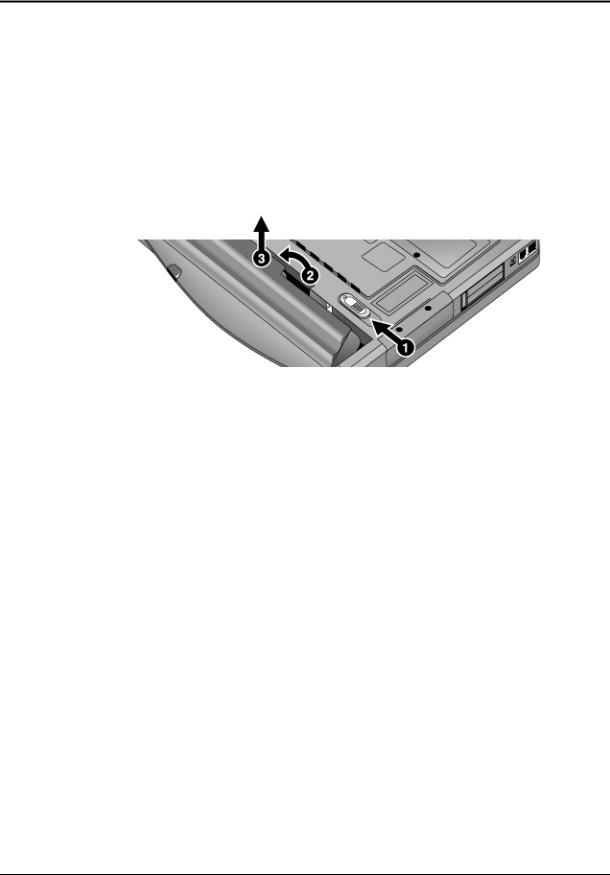
Removing the Battery
(User-Replaceable)
Required Equipment
•None.
Removal Procedure
•Slide the battery’s release latch in the direction of the arrow on the latch, then lift the battery out of its compartment.
Figure 2-2. Removing the Battery
Reassembly Notes
•Insert the front end of the battery into the battery compartment, then press the back end in until the battery clicks into place.
2-4 |
Removal and Replacement |
HP Pavilion zt1100/xz100 Omnibook xt1000 |
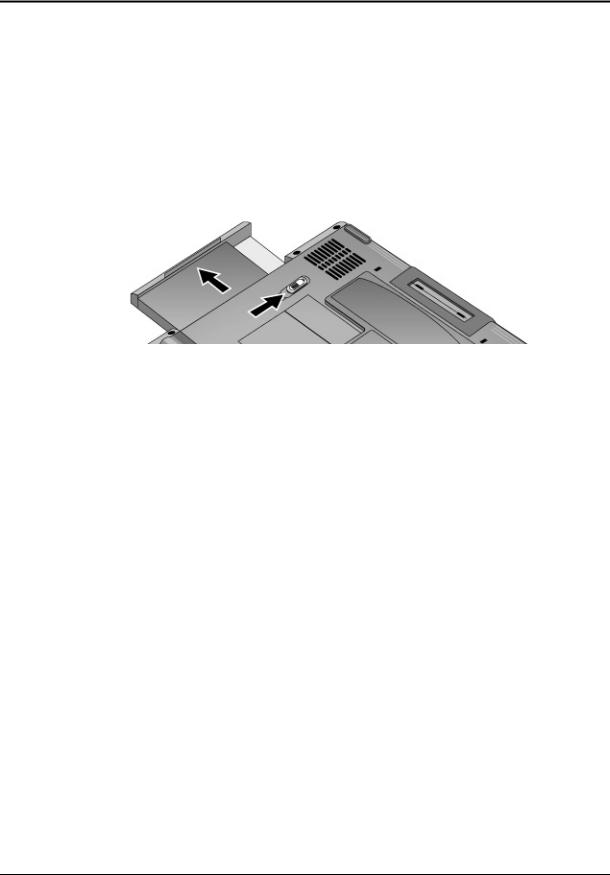
Removing a Plug-In Module
(User-Replaceable)
Required Equipment
•None.
Removal Procedure
•Slide the module release latch in the direction shown by the arrow on the latch, and remove the module.
Figure 2-3. Releasing the Plug-in Module
HP Pavilion zt1100/xz100 Omnibook xt1000 |
Removal and Replacement |
2-5 |

Removing the Hard Disk Drive
(User-Replaceable)
Required Equipment
•#0 Phillips screwdriver.
Removal Procedure
1.Unplug the AC adapter, if present, and remove the battery.
2.On the bottom of the unit, remove both hard drive retaining screws.
Screws,
M2.5×4mm
Figure 2-4. Removing the Hard Disk Drive
3.Carefully pull the hard drive out of the notebook.
4.Remove all four screws from the hard drive tray and drive case, then lift the drive out of the tray.
2-6 |
Removal and Replacement |
HP Pavilion zt1100/xz100 Omnibook xt1000 |

 Screws,
Screws,
M2.5x4mm (2)
Screws,
M2.5x4mm (2)
Figure 2-5. Removing the Hard Disk Tray
Reassembly Notes
•Insert the connector end of the drive through the opening in the tray, then lower the drive into place.
•Carefully slide the hard drive assembly into its compartment. Press firmly to make sure the connector seats properly.
Important
If you are installing a new hard disk drive, install the factory software and operating system on the drive before loading any additional software—see “Recovering and Reinstalling Software,” below.
HP Pavilion zt1100/xz100 Omnibook xt1000 |
Removal and Replacement |
2-7 |

Recovering and Reinstalling Software
Use the Recovery CDs to reinstall the original factory software and operating system. The Recovery CDs also provide all HP notebook–specific Windows drivers, which are available in the following locations:
•On the hard drive, under c:\hp\drivers.
•On the Recovery CDs, under \hp\drivers.
•On the HP Business Support web site (www.hp.com/go/bizsupport). This web site contains the latest updates of software drivers for various operating systems.
To recover the factory software installation
The following procedure describes how to recover the notebook’s original software and operating system. This process can take up to 15 minutes to complete. (For more information about recovering the factory software installation, see the file readme.txt in the root directory of the Recovery CDs.)
Caution
Be sure to back up the hard disk before proceeding. This procedure formats the hard disk, which erases all data on the disk. After formatting, you must reinstall any applications.
Do not interrupt the following process or unplug the AC adapter until the process is complete.
1.Back up all data from the hard disk.
2.Connect the AC adapter to the notebook. This is necessary to provide an uninterrupted power source: the notebook’s battery alone is not adequate.
3.Insert Recovery CD disk 1 into the notebook’s CD/DVD drive. If the notebook is turned off, use a pin or straightened paper clip to press the release switch on the drive door to open it.
4.Turn on or restart the notebook.
5.When the HP logo appears, press Esc to display the Boot menu.
6.Use the arrow keys to select the CD/DVD drive as the first boot device, then press Enter.
7.When the Recovery CD dialog box appears, follow the displayed instructions. If prompted, accept the recommended partition size.
To create the Utility partition without installing the factory software, click Advanced and select not to install the operating system.
If the hard disk is partitioned into several drives, you can install the factory software on drive C without affecting other drives. Click Advanced and select to restore only the C partition.
8.When prompted to reboot the notebook, press Ctrl+Alt+Del and follow any instructions that appear.
Note
Windows XP supports the NTFS file system.
2-8 |
Removal and Replacement |
HP Pavilion zt1100/xz100 Omnibook xt1000 |
